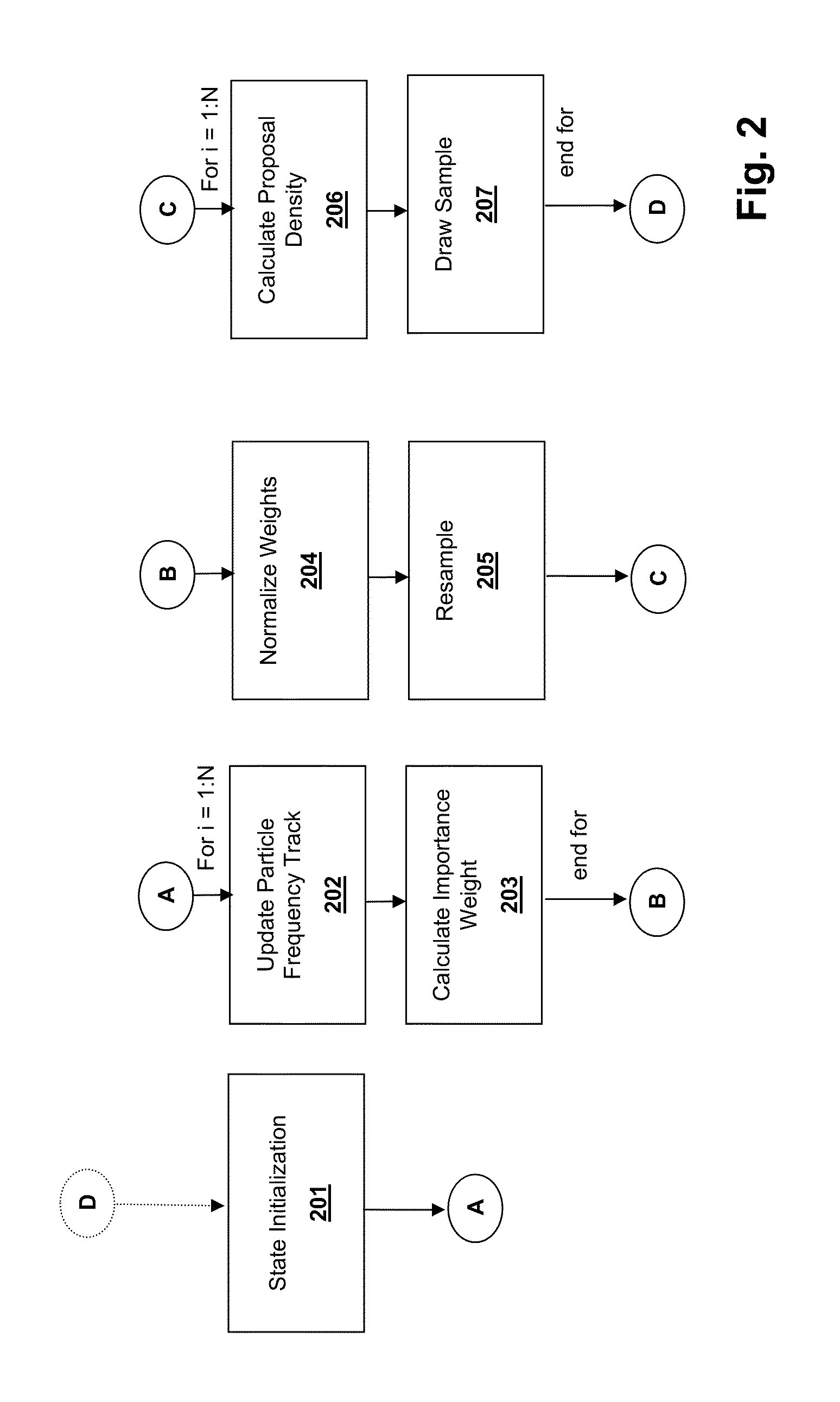Diversified doppler for single platform geolocation
a technology of diversified doppler and single platform, applied in wave based measurement systems, measurement devices, instruments, etc., can solve the problems of gauss-newton method having a strong tendency to produce erroneous estimates, requiring two simultaneous platforms, etc., and achieves more robust and accurate solutions.
- Summary
- Abstract
- Description
- Claims
- Application Information
AI Technical Summary
Benefits of technology
Problems solved by technology
Method used
Image
Examples
example 1
[0096]The performance of the above described DPF algorithm was examined for Doppler data simulated from a recorded UAV path, where the UAV attempts to determine the position of a 500 MHz RF emitter device in a 1 km2 vicinity. The UAV's flight path 501 over a collection period of 3 minutes (180 s) is shown in FIG. 5. As shown, the UAV starts at approximately [0;−600] x-y point with a height of 150 meters and travels at a relatively slow, constant velocity range of from about 8 to about 18 m / s (i.e., about 20-40 mph). The star 502 denotes the position of the target RF emitter, which is placed outside and about 0.5 km from the center of the UAV flight path.
[0097]Referring to FIG. 6, the simulated emitter carrier drift is illustrated 601. As shown, a drift of greater than about 20 Hz over the course of three minutes is well within the operational tolerances (40 parts per billion) for most commercial emitter devices.
[0098]Referring to FIG. 7, a comparison between the expected Doppler fro...
example 2
[0103]Referring to FIG. 10, the performance of a DPF algorithm according to the invention is examined for the case where a target emitter 1302 is located inside the UAV's flight loop 1001. As shown, the star 1002 denotes the position of the target RF emitter and the line 1001 shows the UAV's flight path over a collection period of 3 minutes (180 s). Similar to Example 1, the emitter comprises a variable 500 MHz RF carrier device having the same drift shown in FIG. 6. The UAV starts at approximately [0;−600] x-y point with a height of 150 meters and travels at a relatively slow velocity range of from about 8 to about 18 m / s (i.e., about 20-40 mph).
[0104]Referring to FIG. 11, a comparison between the expected Doppler from a stable 500 MHz signal 1101 and the observed Doppler 1102 from the emitter with the drift described in FIG. 6 and geometry of FIG. 10 is shown. It will be appreciated that the Doppler shift for these speeds and geometry ranges from about −20 to about 20 Hz. As shown...
example 3
[0107]Finally, FIG. 13 compares the best potential performance of the two-sensor FDOA method 1301 to the single-sensor FOA method 1302 by comparing their respective CRLBs. As shown, the geometry was the same as described in FIG. 5, except that the FDOA required a second collector placed at the location of [600;−600; 0]. Both bounds assumed a measurement error variance of 1 Hz2. The results show that FDOA converges slightly faster, but that the performances of the two techniques at the end of the three minute collection are roughly comparable. Note also that the bounds assume that both FDOA sensors have absolute frequency measurements precise to within a Hz.
[0108]Unless specifically stated otherwise as apparent from the above discussion, it is appreciated that throughout the description, discussions utilizing terms such as “processing” or “computing” or “calculating” or “determining” or “displaying” or the like can refer to the action and processes of a data processing system, or sim...
PUM
 Login to View More
Login to View More Abstract
Description
Claims
Application Information
 Login to View More
Login to View More - R&D
- Intellectual Property
- Life Sciences
- Materials
- Tech Scout
- Unparalleled Data Quality
- Higher Quality Content
- 60% Fewer Hallucinations
Browse by: Latest US Patents, China's latest patents, Technical Efficacy Thesaurus, Application Domain, Technology Topic, Popular Technical Reports.
© 2025 PatSnap. All rights reserved.Legal|Privacy policy|Modern Slavery Act Transparency Statement|Sitemap|About US| Contact US: help@patsnap.com



